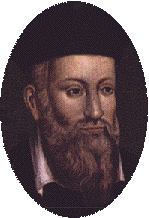July 2: Nostradamus
Nostradamus (d. 1566)
It was on this date, July 2, 1566, that the great prophet of the Middle Ages, Michel de Nostredame, whose Latinized name is Nostradamus, died – as he predicted – in Salon, France. His career, as mystic, doctor, astrologer, apothecary, and writer, was that of a Freethinker, although he died a Catholic. He was born on 14 December 1503 in St. Remi, the son of Jewish parents compelled by the Inquisition to adopt Christianity.
Nostradamus not only studied math, astronomy, astrology and languages, but also graduated from medical school at the University of Montpellier. But his insistence on sanitation and clean water to ward off infection by the Plague seems to have been too heretical for the Inquisition. After losing his first wife and children to the disease, Nostradamus evaded the inquisitors by wandering through France and Italy for some years. Most scholars think Nostradamus sought solace in the mystical arts for the loss of his family, which is why he began making prophecies.
In 1547 Nostradamus settled in Salon, married a rich widow named Anne Ponsarde Gemelle, and exchanged his medical caduceus for a prophet's robes. He started publishing annual almanacs in 1550, and, emboldened by their success, eventually composed the work for which he is known today, The Prophecies of Michel Nostradamus, published in 1555. According to a letter to his son César, which forms the preface to his work, he intended for his prophecies to be obscure because he feared clerical persecution – although one might argue that that should not have been a problem for a man who could see the future!
His prophecies are claimed to have predicted everything from Louis Pasteur and his germ theory of disease, French leader Charles de Gaulle and Hitler, to the explosion of the space shuttle Challenger and the attack on the World Trade Center and Pentagon by Islamic terrorists. And why not? Nostradamus used a technique that prophets and astrologers use to this day: ambiguous specificity – a term coined by Maziar Yafeh and Chip Heath in their review of the methods of the 16th century seer (2003).*
As one critic put it, "Most quatrains refer to deaths, wars or natural disasters, events that are sure to occur again and again throughout history. ... His metaphorical writing highlights general relationships and conflicts, not specific details. People, or possibly nations, are described as animals; major figures are referred to by their attributes."**
One example: Nostradamus is said to have predicted the death of King Henry II of France before the monarch died in a jousting tournament in 1559, accidentally pierced through his visor by the lance of the Comte de Montgomery. The king was 40 and his jousting opponent – who shared with him a lion mascot on his shield – was 29. The quatrain (CI, Q35) goes:
Le lyon ieune le vieux surmontera,
En champ bellique par singulier duelle:
Dans cage d'or les yeux luy creuera,
Deux classes vne, puis mourir, mort cruelle.†
The young lion will overcome the older (one),
In a field of combat in single fight:
He will pierce his eyes in (their) golden cage,
Two wounds (in) one, then (he) dies, (a) cruel death.
Many writers assert that this prophecy made Nostradamus famous in his lifetime, but of course its "ambiguous specificity" made the prophecy meaningless until after the event – at which time the events were fit to the prophecy. Death comes for us all, but predicting the death of kings could shorten your own life. An earlier interpretation, or a more precise prophecy, might have resulted in the prophet's arrest for threatening the king's life!
Of his nearly 1,000 predictions, the one most likely to have been true was never written down by his hand. On 1 July 1566, in failing health, Nostradamus asked a priest to administer last rites. As the priest left, so the story goes, Nostradamus told him, "You will not find me alive at sunrise." In any event, Nostradamus died the next day at age 62.
* Maziar Yafeh and Chip Heath, "Nostradamus's Clever 'Clairvoyance' The Power of Ambiguous Specificity." Skeptical Inquirer 27:5, September/October 2003. At the time they wrote, Maziar Yafeh was a senior at Stanford University majoring in economics and psychology, and Chip Heath was an associate professor of organizational behavior.
** Tom Harris for "How Stuff Works.com," 1998-2004, at this link.
† Text and translation from esoterism.com. Henry was attended at his death by Andreas Vesalius.
Originally published July 2003 by Ronald Bruce Meyer.


